THE GROWING SCOURGE OF AI SLOP AND JOHN OLIVER’S BRILLIANT REBUTTAL
In an age increasingly dominated by digital content, a new phenomenon has emerged, often referred to as “AI slop.” This term describes the deluge of mass-produced, often low-quality, and sometimes misleading content generated by artificial intelligence. From social media feeds to seemingly innocuous image boards, AI slop is proliferating, raising significant concerns about the integrity of information, the erosion of trust, and the fundamental value of human creativity. Late-night satirist John Oliver, known for his incisive deep dives into complex societal issues, recently took aim at this very problem on his show, Last Week Tonight, offering not just a critique but also a surprisingly wholesome and artistic form of revenge.
WHAT IS AI SLOP, AND WHY IS IT A PROBLEM?
AI slop, as Oliver aptly puts it, is content churned out by AI models with minimal human oversight, often for the sole purpose of driving engagement or generating ad revenue. It manifests in various forms, including:
- Generic Articles and Blogs: Reams of text generated on trending topics, often lacking originality, depth, or accurate sourcing.
- Synthetic Images: AI-generated pictures flooding platforms like Pinterest, often indistinguishable from real photography to the casual observer, yet completely fabricated. These images can depict anything from fantastical creatures to realistic-looking but non-existent products or scenes.
- Automated Videos and Audio: Short-form videos with AI-generated narration or visuals, designed to capture fleeting attention.
- Spam and Misinformation: Perhaps the most insidious form, where AI is used to produce and disseminate false narratives, conspiracy theories, or misleading information about critical events like wars or natural disasters.
The proliferation of AI slop presents several grave challenges. Firstly, it clogs the digital ecosystem, making it increasingly difficult for users to discern genuine, high-quality content from automated filler. This overwhelming volume can lead to content fatigue and a general sense of distrust in online information. Secondly, and more dangerously, AI-generated disinformation poses a serious threat. As Oliver highlighted, AI’s capacity to create convincing but utterly fabricated content about sensitive topics like ongoing conflicts or natural disasters can have real-world consequences, impeding the work of first responders and fostering widespread panic or confusion.
Beyond the practical concerns, there’s a profound ethical dilemma at the heart of AI slop: the issue of intellectual property and artistic integrity. Many of the large language models and image generators that produce this content are trained on vast datasets scraped from the internet. This includes copyrighted images, written works, and artistic creations without explicit permission or compensation to the original human creators. As Oliver pointed out, the technology “only works because it trains on the work of actual artists.” This practice amounts to an unacknowledged and uncompensated appropriation of human labor, undermining the value of genuine artistic endeavor and potentially leaving human artists struggling to compete with free, AI-generated alternatives.
JOHN OLIVER’S INCISIVE CRITIQUE
John Oliver’s segment meticulously dissected these issues, emphasizing the multi-faceted harm caused by AI slop. He articulated the problem with his characteristic blend of humor and sharp insight:
“AI slop can be somewhat lucrative for its creators, massively lucrative for the platforms that use it to drive engagement, and worryingly corrosive to the general concept of objective reality.”
This quote encapsulates the core of the problem. While AI slop might offer quick profits for its producers and increased user engagement for platforms, its long-term impact is far more detrimental. It erodes the foundational principle of objective reality, making it harder for individuals to distinguish fact from fiction, truth from fabrication. This erosion of trust, Oliver argues, is not merely an inconvenience; it’s a societal threat. The segment highlighted specific examples, such as AI-generated news articles that recycle old information or images that create entirely false scenarios, illustrating how easily misinformation can spread and become embedded in the public consciousness.
Oliver also underscored the ethical outrage of AI training data. He vocalized the frustration of countless artists and creators who see their life’s work, their unique styles, and their intellectual property being ingested and repurposed by algorithms without consent or credit. The humor in his segment was, as ever, a vehicle for a serious message: even when AI-generated content seems funny or bizarre, that enjoyment is deeply “undercut when you know that someone’s hard work was stolen in order to create it.” This perspective shifts the narrative from mere technological novelty to a critical examination of exploitation and fairness in the digital age.
THE CREATIVE COUNTER-ATTACK: REAL ART VERSUS REPLICATED SLOP
Faced with this pervasive and problematic trend, Oliver proposed a counter-intuitive yet deeply symbolic solution: “Create real art by ripping off AI slop.” This was not a call for more AI; rather, it was an artistic act of defiance. To illustrate his point, he commissioned Michael Jones, a highly skilled chainsaw sculptor whose authentic work had ironically been used without permission to train AI models, leading to the creation of viral AI imagery.
Oliver challenged Jones to transform what he considered “the finest and most inexplicable piece of slop produced to date” into a physical, tangible work of art. The chosen AI-generated image was intentionally abstract and bizarre, representing the nonsensical nature of much of the AI slop. By taking this digital “slop” and having a human artist painstakingly recreate it in a traditional medium, Oliver aimed to make several profound statements:
- Reclaiming Creativity: It demonstrated that true creativity, skill, and human interpretation are irreplaceable. Jones’s work was not a mere copy but an act of translation, breathing new life and genuine artistry into a soulless digital construct.
- Highlighting Labor and Value: The physical effort, precision, and years of skill required for Jones to carve a detailed sculpture from wood stood in stark contrast to the instantaneous, effortless generation of AI images. It reminded viewers of the immense value of human labor and craftsmanship.
- Symbolic Justice: By paying a human artist whose work had been implicitly “stolen” by AI, Oliver enacted a small but meaningful form of reparation. It was a tangible way to support and recognize the human element that AI often seeks to sideline.
- Subverting the Narrative: Instead of fighting AI with more AI, or simply condemning it, Oliver chose to use human ingenuity to highlight AI’s inherent limitations and dependency on human input. He turned a negative (AI slop) into a positive (human art).
The end result, a magnificent wood sculpture based on the inexplicable AI image, was indeed a masterpiece. It served as a powerful visual metaphor for the ongoing battle between authentic human creativity and the burgeoning tide of synthetic content. It was a tangible testament to the idea that while AI can replicate, it cannot truly originate in the same way human artists do.
BROADER IMPLICATIONS AND THE FUTURE OF CONTENT
John Oliver’s segment is more than just entertainment; it’s a critical commentary on the evolving digital landscape. The “AI slop” phenomenon is not isolated; it’s part of a larger trend that forces us to reconsider fundamental questions about authorship, truth, and value in the information age. As AI models become more sophisticated, the line between human-created and machine-generated content will blur even further, making media literacy more crucial than ever.
This situation demands a multi-pronged approach:
- Platform Accountability: Social media platforms and search engines need to implement stricter measures to identify and curb the spread of AI-generated misinformation and spam. Transparency about content origin should be paramount.
- Legal and Ethical Frameworks: Governments and international bodies must develop robust copyright laws and ethical guidelines for AI training data, ensuring fair compensation and attribution for original human creators. The debate around opt-out mechanisms for artists is crucial here.
- Education and Media Literacy: Users need to be equipped with the tools to critically evaluate online content, understand the capabilities and limitations of AI, and recognize signs of AI slop.
- Support for Human Creativity: Actively seeking out and compensating human artists, writers, and creators becomes even more vital. Consumers have a role to play in valuing authenticity over automated convenience.
- Responsible AI Development: AI developers themselves bear a responsibility to build models that respect intellectual property and are designed with ethical considerations from the outset, rather than as an afterthought.
Oliver’s approach, transforming AI slop into a work of human art, offers a beacon of hope and a practical demonstration of resistance. It reminds us that while AI can mimic and synthesize, the unique spark of human creativity, the emotion, intention, and lived experience that fuel genuine art, remains unparalleled. The joy and satisfaction derived from a piece of art created by human hands, like Michael Jones’s sculpture, cannot be replicated by an algorithm, no matter how advanced.
CONCLUSION: CHAMPIONING AUTHENTICITY IN THE DIGITAL AGE
The rise of AI slop presents a formidable challenge to our collective understanding of reality and the future of human creativity. John Oliver’s segment on Last Week Tonight served as a vital wake-up call, dissecting the nuances of this issue with characteristic clarity and wit. His ingenious act of commissioning a human artist to transform AI-generated nonsense into a tangible, beautiful sculpture was more than just a comedic punchline; it was a profound statement. It championed the irreplaceable value of human skill, intention, and artistry in a world increasingly saturated with artificial substitutes.
As we navigate the complexities of the AI revolution, the responsibility falls on all of us – creators, platforms, policymakers, and consumers – to prioritize authenticity, support human talent, and remain vigilant against the forces that seek to corrode our shared reality. Oliver’s “revenge” against AI slop serves as a powerful reminder that while technology can advance at dizzying speeds, the human spirit of creation remains the ultimate masterpiece.

